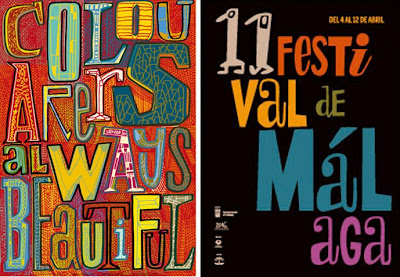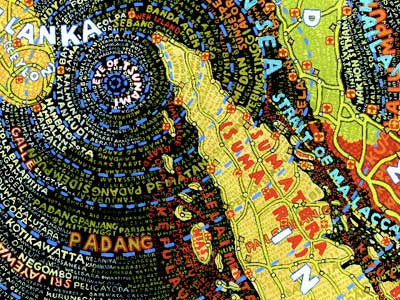Introduction
HoneyHome.com is a design project that revolves around the notion of a community focal point. Its aim was to “develop a new service through which a supermarket engages on a local level with its customers and other in the community […] to increase the resourcefulness of the local community and individuals” (RSA Design Directions, 2009, p.17).
The project responds to the brief with four distinctive elements: a concept, a wall-size touch-screen device, an associated website and a promotional campaign.
In this paper, I intend to critically assess the project by looking into its key stages: (i) research and strategy, (ii) design concept, (iii) design development, (iv) implementation, and (v) evaluation.
Research and strategy
I used many different methods of research throughout the project. I conducted an extensive secondary research into the role of media in building and maintaining communities, the changeable nature of communities, the future of magazines, existing community projects, tangible technologies and relevant issues for design.
While investigating touch-screen technologies and their possible applications within local communities, I combined the secondary research with observation techniques. I collected web-sourced images of digital kiosks, community notice boards and other touch-screens used for information, education or retail purposes. More importantly, I took my own photographs of such devices in museums (Science Museum, National History Museum) and on the streets of my local town.
Similarly, while collecting information about existing local magazines I used qualitative and quantitative methods of data analysis in order to gain a better understanding of the market and its dynamics.
Other primary research methods were also widely used. I interviewed an expert on magazine industry to test my initial ideas. The peers and tutors feedback was often considered. In addition, I kept discussing my work in progress with colleagues, friends and family as the project was targeted at all supermarket customers, people of different classes, cultures, ages and lifestyles.
Finally, I used methods of visual exploration, such as mind maps, sketches, mock-ups, storyboards and diagrams to organize my thoughts and research findings. I believe that by combining all of the above methods, I based my project on solid and sufficient research. Consequently, I was able to better understand the project brief and formulate clear strategic objectives for the project.
Design Concept
During the early stages of the concept development, I planned to incorporate the notions of community networking and cooperation into my design by comparing it to the DNA structure. However, I realized that to my targeted audience the DNA’s scientific and medical associations might be unfamiliar, confusing and difficult to understand. Therefore, I decided to modify the concept and the ‘community DNA’ became the ‘community honeycomb’.
As opposed to a DNA, honey is a popular grocery product that can be seen, touched, smelled and tasted. “Honey is a symbol of richness and sweetness in all traditions. In the sacred texts of East and West, milk and honey flow like a stream through the Promised Land. The Celtic traditions celebrate mead as an immortal beverage. In Greek mythology, in which honey is the drink of the gods of Olympus, it is the symbol of knowledge, learning and wisdom” (Bernard Michaud, [n.d.], [n.p.]). Moreover, the very concept of networking derived from social insects, such as bees. “As the workers of the hive, bees are symbol of an industrious and prosperous community” (Bernard Michaud, [n.d.], [n.p.]).
Design Development
I successfully incorporated these good associations into my designs by using a hexagon motif throughout the project. Simple geometric shapes are known to carry symbolic, easily identifiable meanings and messages. While circle stands for unity and a squire for stability, a hexagon represents colabaration - a key characteristic of a prosperous community.
The honeycomb inspired also the project name, which evolved from the ‘Community Honeycomb’ to the ‘HoneyHome.com’, which sounds more playful and points towards the online presence of the project. Consequently, the in-store, wall-size, digital device was named ‘The Hive’.
I used images of honeycombs to develop the colour palette for the project. Shades of bright yellow, golden, warm orange and lime green enhance the concept by expressing the associations with sun, summer and harvests.
I selected two contrasting typefaces: Helvetica (for body text and secondary text) and Hobo (for logos). The feedback I received during the post-production tutorial suggested that the Hobo font, originally created in 1910 by Morris Fuller Benton, might be a little dated as it referred to the Art Nouveau style. I do understand this argument, but after considering modern alternatives I decided to keep the original font because of its organic, floral motifs, as well as highly-stylized, flowing curvilinear forms and friendly personality. I do feel that it is suitable for HoneHome.com project.
Design Implementation
I believe I developed a very original and unique logo for the project and campaign by intersecting horizontally and the words: ‘honey’, ‘home’ and ‘.com’ as well as replacing the common ‘O’ with a yellow hexagon.
I designed the ‘home screen’ for the in-store device and its website, as well as a simple promotional campaign. The ‘Sweet Campaign’ involves printing the HoneyHome.com logo with a catchy slogan, such as “Sweetening Your Local Community” or “Buzzing With Activity”, on supermarkets’ carrying bags, shopping baskets and trolleys. Similarly, locally-sourced honey could be used for promotional purposes.
Evaluation
I believe that I managed to successfully develop the HoneHome.com concept. However, its implementation could be further improved. The interfaces for the device applications as well as the website need to be developed.
Similarly, the campaign could be extended further. I thought about designing a system of floor signs that would point customers from different parts of the supermarket towards ‘The Hive’ and encourage them to interact with the device. The label for the ‘Homely Honey’ jar I created for the campaign also needs to be redesigned. I feel that my packaging design skills were insufficient on this occasion.
This might be due to the fact that I spent most of my time on the project working on the concept development and was left short of time during the design implementation stage. If I were to work on a similar project again, I would manage my time more efficiently.
Also, I would make my research more structured, systematic and objective, especially in the post-production stage of the project. I would try to develop a prototype of the HoneyHome.com website in order to show more detail about the possible applications of the concept. The prototype would have allowed me to accurately test the functionality of The Hive among the targeted audience and to improve the design of the device and the website.
In terms of professional growth, I feel that I have leant a lot on this project. I extended my academic and industry knowledge and improved my practical design skills. Taking into consideration that I come from journalistic rather than graphic design background, I did find the project quite challenging. However, I truly enjoyed that challenge and I am looking forward to utilize my newly acquired skills in the future.
Conclusion
In general, I find my project successful. I believe that, despite its weaknesses and limitations, HoneyHome.com has a potential to restore the community focal point. I think that I managed to develop a practical design solution to problems outlined by the project brief and investigated through various methods of research. In my opinion, the project offers the unique balance between the interests of supermarkets, individuals and existing communities. It shows how supermarkets could “demonstrate commitment to their locality and create bonds of reciprocity between themselves, their customers and the greater community” (RSA Design Directions, 2009, p.17).
References
Bernard Michaud (n.d.). Mythology of Bees Honey [online]. Available from: www.lunedemiel.tm.fr/anglais/06.htm [Accessed: 15 January 2010].
RSA Design Directions (2009). The Resourceful Supermarket [online]. Available from: www.rsadesigndirections.org/projects/projects6.html [Accessed: 10 October 2009].
Bibliography
Anderson, W.T. (1999) Communities in a World of Open Systems. Futures. 31(5), 457-463.
Bernard Michaud (n.d.). Mythology of Bees Honey [online]. Available from: www.lunedemiel.tm.fr/anglais/06.htm [Accessed: 15 January 2010].
Churchill, E.F., Nelson, L. and Denoue, L. (2003). Multimedia Flyers: Information Sharing with Digital Community Bulletin Boards [online]. Available from: www.fxpal.com/publications/FXPAL-PR-03-198.pdf [Accessed: 16 November 2009].
Dorf, D. (2008). Web 2.0 Honeycomb [online]. Available from: http://blogs.oracle.com/retail/2008/12/web_20_honeycomb.html [Accessed: 27 November 2009].
Leight, S. (2008). Supermarkets are evil: what a shame we love Tesco and Waitrose so [online]. Available from: www.telegraph.co.uk/comment/columnists/samleith/3563175/Supermarkets-are-evil-what-a-shame-we-love-Tesco-and-Waitrose-so.html [Accessed: 23 October 2009].
Michaels, L. (2001). What’s Wrong with Supermarkets [online]. Available from: http://archive.corporatewatch.org/publications/agriculture/www_sm_v4.pdfAccessed: 23 October 3009).
Ribeirinho, A. (2007). The User Experience Honeycomb [online]. Available from: http://blog.delaranja.com/the-user-experience-honeycomb/ [Accessed: 27 November 2009].
RSA Design Directions (2009). The Resourceful Supermarket [online]. Available from: www.rsadesigndirections.org/projects/projects6.html [Accessed: 10 October 2009].
Slattery, J. (2009). Local Media’s Community Building Role at Risk [online]. Available from: http://jonslattery.blogspot.com/2009/05/local-medias-community-building-role-at.html [Accessed: 4 November 2009].
Smith, G. (1995).Virtual Community in Real Reality [online]. Available from: www.partnerships.org.uk/itf/virtreal.html (Accessed: 10 November 2009).
Wednesday 27 January 2010
Critical Reflection on Design Project A
Posted by
Katarzyna Matuszewska
11:04
0
comments
About Me

- Katarzyna Matuszewska
- I grew up in a small town in Poland believing that the only boundaries that should not be crossed were those which I set up for myself. Now, living in the cultural blur of a cosmopolitan city I stick to that rule. I cross boundaries between cultures, languages, between print and web, between journalism and design in search of original creative fusions. I graduated from University of Westminster in 2010 with a Masters Degree with Distinction in Design for Communication. I also hold a First Class BA in Journalism with Media and Cultural Studies from Kingston University, which gives me a combined knowledge of editorial and design practices. Having previously worked for The Sunday Times Magazine, Haymarket and Think Publishing, I have experience in publishing and design industries and a strong passion for editorial design. I am a great (bilingual) communicator, a competent writer and a designer. I produce imaginative magazine layouts to convey the publication‘s editorial mission and specialise in magazine launch and redesign projects. If you think your organisation could benefit from my knowledge and experience, please get in touch.
Blog Archive
Followers
Labels
- Advertising (1)
- Book Design (7)
- Business for Design (8)
- Colour (2)
- Community (7)
- Critical Debates in Design (9)
- Design Authorship (8)
- Design Inspirations (1)
- Design Project B (7)
- Design Research Methods (8)
- Environment (5)
- Ethics (5)
- Honeycomb (3)
- Interactivity (7)
- Logo (4)
- Market Research (3)
- Master Project (1)
- Personal Projects (1)
- Printing (1)
- Project Brief (4)
- Redesign (1)
- RSA (24)
- Tasks (17)
- Touch Screen (11)
- Typography (3)









